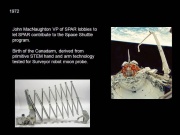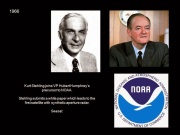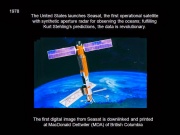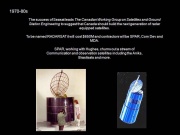100 Years of Aerospace History in Canada: From McCurdy to Hadfield Part 10 by Robert Godwin
From The Space Library
SPAR's Evolution, Stehling in the States and RADARSAT's Origins
The story of SPAR's evolution into the world's leading purveyor of space robotics begins once again with the STEM. SPAR's management had been looking for other applications for STEM beyond its most popular use as a long antenna.
Dr Lapp later wrote, "One of the applications had been as a miniature steam shovel or backhoe. Wires were run down the centre of the STEM tube and attached to a gripper or shovel at its tip. This could then be used to take samples for analysis or Earth return. A rudimentary unit was used on the Surveyor spacecraft that went to the moon in advance of Apollo. Clearly this was a precursor to the arm on the shuttle." [i]
One of the principle uses for robotic arms at this time was to handle nuclear elements such as hot fuel rods. The United States had even built an enormous armed vehicle called "The Beetle" for just this purpose on the Project Rover nuclear rocket engine program. By 1972 Canada was at the forefront of nuclear reactor design and Atomic Energy of Canada had issued contracts to SPAR to make STEM devices for assisting in fuelling CANDU reactors. Phil Lapp recorded that the "Cartesian" approach of using X and Y controls for these handling devices led to the anthropomorphic arm on the shuttle.
When the space shuttle program first began to evolve in the United States the consideration of costs was paramount and it was decided to defray some of these costs by inviting international partners to the table. A Canadian firm named Dilworth, Secord and Meagher (DSMA) had been at the root of the CANDU rod handling system and they approached NASA to consider their ideas for the proposed orbiting space telescope then under consideration. Because DSMA had no manufacturing capability they approached Dr Lapp about having SPAR take on their construction work. As the project evolved John MacNaughton, VP of SPAR, persuaded the National Research Council that Canada should also bid on an arm for the shuttle system. SPAR would be prime contractor, RCA would do the electronics, CAE Industries would come in to handle simulations and human factors, and DSMA would handle the test equipment.[ii]
Despite NASA having instigated this foreign involvement in the shuttle, American industry was dead set against the idea and began to lobby Congress to shut Canada out. In the end MacNaughton had to fight fire with fire and hired a lobbying firm to work on behalf of SPAR in Washington. SPAR ultimately prevailed and work began on the arm project in the early 1970s.
Pressure was enormous on the SPAR team, who were expected to deliver cutting edge technology in time for a drop-dead date for first launch, while simultaneously keeping the Canadian government happy by evolving the spin-off businesses for Canadian industry. SPAR met almost all of their goals on time including passing a critical design review by NASA in 1978.
While the details seemed to all be in order, some very big questions fell through the cracks. For example towards the end of development NASA thought they were only obliged to buy two arms from SPAR while SPAR thought it was four. Then an argument ensued over who would pay the duty at customs and whether the arms were even liable for duty since they would be leaving the country! NASA didn't want to pay the tax, which on a $15M arm was substantial. However, many of the components for the arm had been made in the USA; to placate US industry into allowing Canadian involvement. The Canadian government agreed to waive the duties on those American parts, which left NASA to pay the duties on the rest of the arm that had originated in Canada.[iii]
Needless to say these problems were resolved and the remote manipulator system, nick-named the Canadarm, flew into space in 1981 and continued to provide stellar service to space shuttle crews for the next thirty years.
Kurt Stehling had been extremely busy since relocating to the United States in 1950. At IAC in 1953 he had again proposed the use of radar on a satellite to study the earth's surface.[iv] He went on to write a white paper on a project which would later become known as Seasat. This project proposed the use of radar altimetry for monitoring ocean currents and resources. This was a subject already of keen interest to Canada. Mapping the high arctic in detail was of considerable importance to the government and to resource industries.
By 1966 Stehling was working with US Vice President Humphrey, in an organization which was the precursor to NOAA, where he wrote more papers pushing the concept of a radar satellite to study the ocean and sea ice.
When Seasat launched in 1978 it was the first satellite to use synthetic aperture radar (SAR) and it unveiled the topography of the ocean for the first time. Despite the unanticipated early shutdown of Seasat and the tantalizing initial results NASA decided not to launch Seasat-2. The Canadian Working Group on Satellites and Ground Station Engineering decided that Canada should take up the challenge of building the next generation of radar equipped satellites.
In 1980 an office was established to house this project. Government approval seems to have come quickly and the contracting companies were SPAR (again thanks to Phil Lapp's ability to strip down the proposal to something affordable), COM DEV and MacDonald Dettwiler (MDA) who would handle the synthetic aperture radar and its data. This project would evolve over the next fifteen years during which time many things would change, not least being the passing of the Canadian Space Agency Act which finally gave Canada its own central space agency.
Now christened RADARSAT this new satellite would operate on some of the principles already well understood from the ISIS and Alouette top-sounders. Certainly the wavelengths were different, but the principle of reflecting an electromagnetic wave down from above was in keeping with many of the things in Canada's aerospace repertoire. RADARSAT would become a staggeringly expensive undertaking for a country as small (economically) as Canada, but was considered essential for a country so large (geographically).
The rewards from a successful mission would quickly become self evident. Dr Gordon Shepherd, who had done such sterling work at Churchill, later became one of the principle scientists involved with RADARSAT. Despite early estimates of $279M to build it, Shepherd estimated that the total budget came in closer to $620M and was spread around 100 international and Canadian organizations. About 80% of that money came from the Canadian Federal Government, which gives some indication of the importance attributed to the mission.[v]
The SAR system developed for RADARSAT used a unique system of multiple beams with variable resolution and was the result of eight years of research by government agencies and Intera Technologies of Ottawa.[vi]
Footnotes
[i] Phil Lapp Memoir Pg 205
[ii] Ibid. Pg 209
[iii] John MacNaughton memoir via Phil Lapp Pg 221
[iv] Earth Scanning techniques for a small orbital rocket vehicle, Kurt Stehling, 1953 Astronaut. Congrs, 4th Zurich
[v] Canada's 50 years in Space, Gordon Shepherd and Agnes Kruchio, Apogee Books, 2008
[vi] Globe and Mail Jun 26 1987




